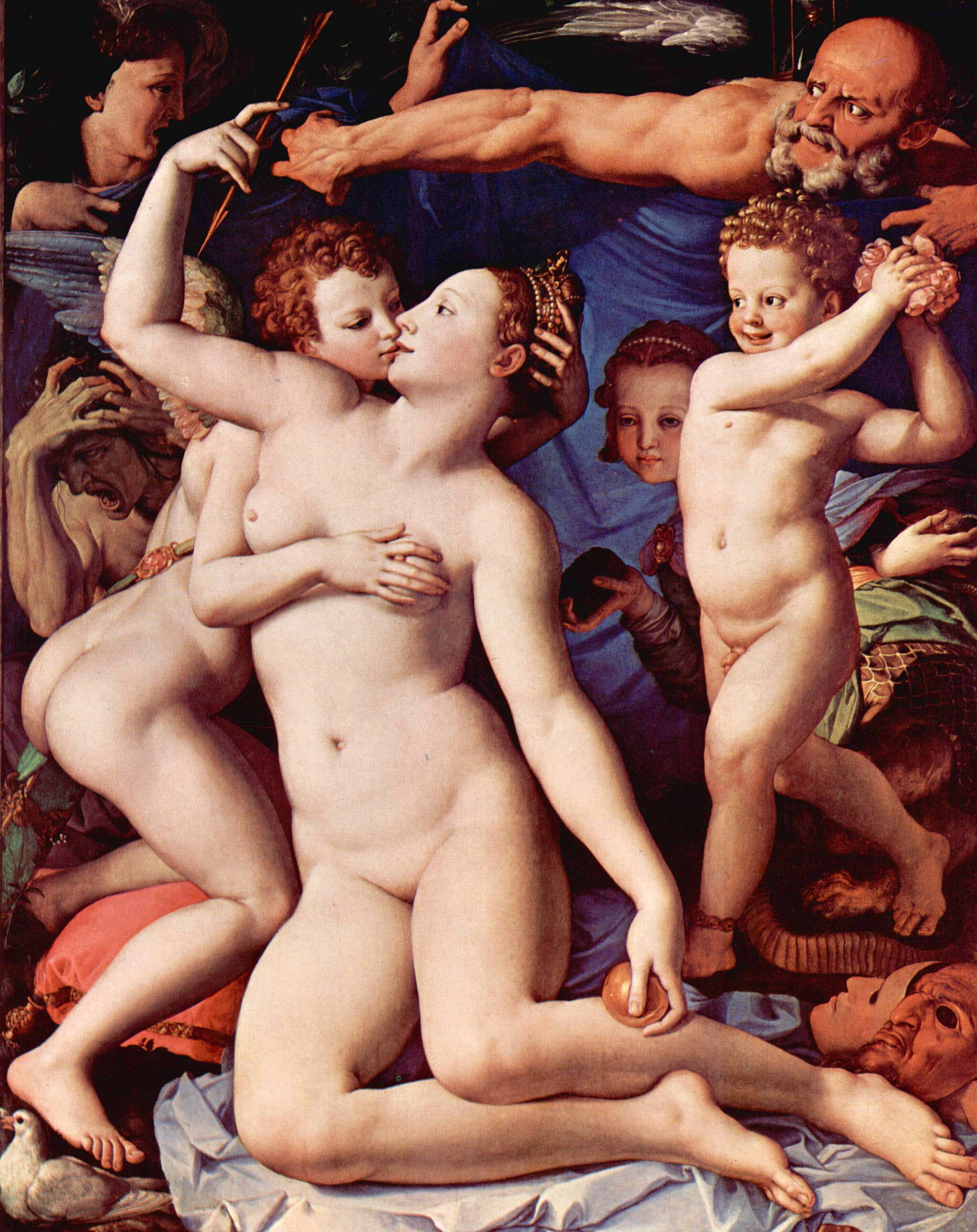- Venus, Cupid, Folly and Time
Infobox Painting|

title=Venus, Cupid, Folly and Time
artist=Agnolo Bronzino
year=circa 1545
type=Oil on wood
height=146
width=116
city=London
museum=National Gallery"Venus, Cupid, Folly, and Time" is an allegorical painting by the Florentine artist
Agnolo Bronzino now in theNational Gallery, London .Around 1545, Bronzino was commissioned to create a painting which has come to be known as "Venus,
Cupid , Folly, and Time". It displays the ambivalence, eroticism and obscure imagery which is characteristic of the Mannerist period, and of Bronzino's masterPontormo .The painting may have been commissioned by the Duke of Florence,
Cosimo de' Medici or by Francesco Salviati, to be presented by him as a gift toFrancis I of France .Vasari wrote that it was sent to King Francis, though he does not specify by whom. The erotic imagery would have appealed to the tastes prevalent in both theMedici and French courts at this time. The attention to texture andwealth is also consistent with Bronzino'saristocrat icpatron age. The figure of Venus can be likened to a precious object (such as a marble statue) in a luxurious setting, desirable because of her unavailability.Crowded into the claustrophobic foreground of the painting are several figures whose identities have been the subject of extensive scholarly debate. The themes of the painting appear to be
lust ,deceit , andjealousy . At times it has also been called "A Triumph of Venus". Its meaning, however, remains elusive.The two central figures are easily identified by their attributes as Venus and Cupid. For example, she holds the golden apple she won in theJudgement of Paris , while he sports the characteristic wings andquiver . Both figures are nude, illuminated in a radiant white light. Cupid fondles his mother's bare breast and kisses her lips. Even more bizarre is the subtle element of Venus's tongue; she appears to be on the verge of slipping it into Cupid's mouth. This tiny detail was evidently the most scandalous aspect of all and at least one previous owner had it painted out over the years. Cupid appears to be nearing adolescence--notably older than the cherubic Cupid who appears in other works, and edging into the age where he might be old enough to make love to his mother--while Venus is portrayed as a beautiful young woman in her twenties. It has been suggested that Venus' legs appear to be slightly spread, possibly to indicate she is ready to receive Cupid sexually. Venus is shown holding Cupid's arrow which perhaps implies that she is in control of their lovemaking. As the couple seem on verge of a sexual tryst, they are also about to be showered from behind with rose petals by a naked boy, believed to representFolly . Another meaning that could be derived, would be through the detail of cupid's hand on his mother's crown, as if to say "Be careful of who you love, you never know if they have honorable intentions."Thebeard ed,bald figure to the upper right of the scene is believed to be Time, in view of the hourglass behind him. He sweeps his arm forcefully out to his right. Again, it is difficult to interpret his gesture with any certainty; it could be to prevent the figure at the far left of the picture from shielding theincest uous transgressions of Venus and theadolescent Cupid with the billowing blue fabric that provides a screen between the figures in the fore and background. Many believe that his gesture seems to say, "Time is fleeting, and you never know when it may be all over." The figure opposite time, and also grasping at the drapery, is usually referred to asOblivion due to the lack of substance to his form--notice the eyeless sockets and the mask-like head. The mask-like face of this figure is echoed by the image of two actual masks in the lower right-hand corner.The identity of the remaining figures is even more ambiguous. The old woman rending her hair (see detail at right) has been called
Jealousy —though some believe her to represent the ravaging effects ofsyphilis (result of unwise intercourse). The creature at the right hand side behind Folly, with a girl's face and grotesque body, extending ahoneycomb with her left hand attached to her right arm, may representFraud . There is, however, no consensus on these identifications.Modern usage
The painting was one of the inspirations of
Mario Vargas Llosa 's novel "Elogio de la madrastra" ("In Praise of Stepmother "), published in 1988. A detail from it is usually reproduced on the cover of editions of that work. A 1959 short story byPeter Matthew Hillsman Taylor is also entitled "Venus, Cupid, Folly and Time."The foot of Cupid was used by
Terry Gilliam in the opening animated titles of "Monty Python's Flying Circus ", usually crushing cartoons or the title of the show.The foot was used as part of a wayfinding system in London's
Museum of the Moving Image (MOMI). As visitors travelled through the museum they would see the foot become gradually more swollen and blistered.A portion of the image (Venus and Cupid) was used by Enigma in the cover for the single "
Principles of Lust ".The painting resided in the Commandant's office in
Lina Wertmüller 'sSeven Beauties .External links
* http://www.nationalgallery.org.uk/cgi-bin/WebObjects.dll/CollectionPublisher.woa/wa/work?workNumber=ng651
Wikimedia Foundation. 2010.
